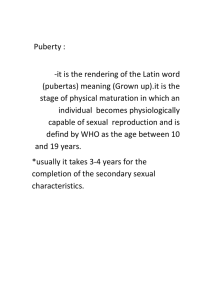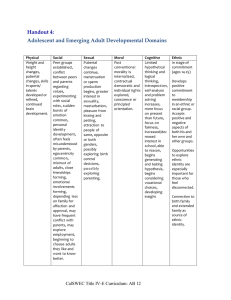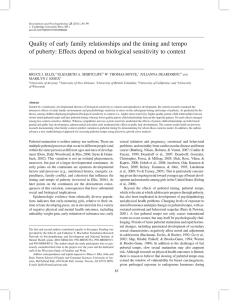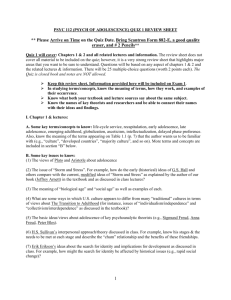Family Environments, Adrenarche, and Sexual Maturation: A Longitudinal Bruce J. Ellis
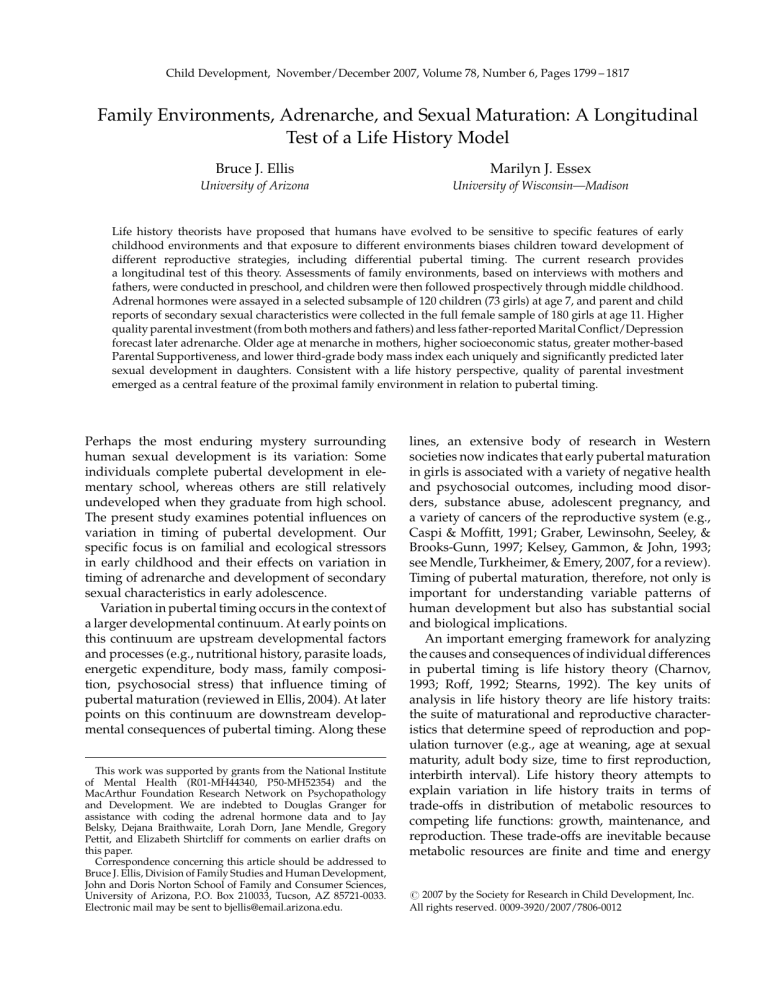
Child Development, November/December 2007, Volume 78, Number 6, Pages 1799 – 1817
Family Environments, Adrenarche, and Sexual Maturation: A Longitudinal
Test of a Life History Model
Bruce J. Ellis
University of Arizona
Marilyn J. Essex
University of Wisconsin—Madison
Life history theorists have proposed that humans have evolved to be sensitive to specific features of early childhood environments and that exposure to different environments biases children toward development of different reproductive strategies, including differential pubertal timing. The current research provides a longitudinal test of this theory. Assessments of family environments, based on interviews with mothers and fathers, were conducted in preschool, and children were then followed prospectively through middle childhood.
Adrenal hormones were assayed in a selected subsample of 120 children (73 girls) at age 7, and parent and child reports of secondary sexual characteristics were collected in the full female sample of 180 girls at age 11. Higher quality parental investment (from both mothers and fathers) and less father-reported Marital Conflict/Depression forecast later adrenarche. Older age at menarche in mothers, higher socioeconomic status, greater mother-based
Parental Supportiveness, and lower third-grade body mass index each uniquely and significantly predicted later sexual development in daughters. Consistent with a life history perspective, quality of parental investment emerged as a central feature of the proximal family environment in relation to pubertal timing.
Perhaps the most enduring mystery surrounding human sexual development is its variation: Some individuals complete pubertal development in elementary school, whereas others are still relatively undeveloped when they graduate from high school.
The present study examines potential influences on variation in timing of pubertal development. Our specific focus is on familial and ecological stressors in early childhood and their effects on variation in timing of adrenarche and development of secondary sexual characteristics in early adolescence.
Variation in pubertal timing occurs in the context of a larger developmental continuum. At early points on this continuum are upstream developmental factors and processes (e.g., nutritional history, parasite loads, energetic expenditure, body mass, family composition, psychosocial stress) that influence timing of pubertal maturation (reviewed in Ellis, 2004). At later points on this continuum are downstream developmental consequences of pubertal timing. Along these
This work was supported by grants from the National Institute of Mental Health (R01-MH44340, P50-MH52354) and the
MacArthur Foundation Research Network on Psychopathology and Development. We are indebted to Douglas Granger for assistance with coding the adrenal hormone data and to Jay
Belsky, Dejana Braithwaite, Lorah Dorn, Jane Mendle, Gregory
Pettit, and Elizabeth Shirtcliff for comments on earlier drafts on this paper.
Correspondence concerning this article should be addressed to
Bruce J. Ellis, Division of Family Studies and Human Development,
John and Doris Norton School of Family and Consumer Sciences,
University of Arizona, P.O. Box 210033, Tucson, AZ 85721-0033.
Electronic mail may be sent to bjellis@email.arizona.edu.
lines, an extensive body of research in Western societies now indicates that early pubertal maturation in girls is associated with a variety of negative health and psychosocial outcomes, including mood disorders, substance abuse, adolescent pregnancy, and a variety of cancers of the reproductive system (e.g.,
Caspi & Moffitt, 1991; Graber, Lewinsohn, Seeley, &
Brooks-Gunn, 1997; Kelsey, Gammon, & John, 1993; see Mendle, Turkheimer, & Emery, 2007, for a review).
Timing of pubertal maturation, therefore, not only is important for understanding variable patterns of human development but also has substantial social and biological implications.
An important emerging framework for analyzing the causes and consequences of individual differences in pubertal timing is life history theory (Charnov,
1993; Roff, 1992; Stearns, 1992). The key units of analysis in life history theory are life history traits: the suite of maturational and reproductive characteristics that determine speed of reproduction and population turnover (e.g., age at weaning, age at sexual maturity, adult body size, time to first reproduction, interbirth interval). Life history theory attempts to explain variation in life history traits in terms of trade-offs in distribution of metabolic resources to competing life functions: growth, maintenance, and reproduction. These trade-offs are inevitable because metabolic resources are finite and time and energy
# 2007 by the Society for Research in Child Development, Inc.
All rights reserved. 0009-3920/2007/7806-0012
